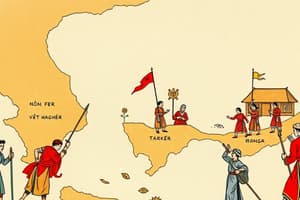Podcast
Questions and Answers
Ai là lãnh đạo nổi bật của phong trào kháng chiến chống lại sự chiếm đóng của Trung Quốc?
Ai là lãnh đạo nổi bật của phong trào kháng chiến chống lại sự chiếm đóng của Trung Quốc?
- Bà Triệu (correct)
- Trần Hưng Đạo
- Lý Thường Kiệt
- Lê Lợi
Cuộc nổi dậy của Bà Triệu chủ yếu tập trung vào điều gì?
Cuộc nổi dậy của Bà Triệu chủ yếu tập trung vào điều gì?
- Thương mại và kinh tế
- Liên minh với các nước khác
- Giáo dục và văn hóa
- Khôi phục lãnh thổ bị mất (correct)
Phong trào kháng chiến của Bà Triệu đã diễn ra ở đâu?
Phong trào kháng chiến của Bà Triệu đã diễn ra ở đâu?
- Tây Nguyên
- Phía bắc Việt Nam
- Nam Bộ
- Miền trung Việt Nam (correct)
Kết quả cuối cùng của cuộc nổi dậy do Bà Triệu lãnh đạo là gì?
Kết quả cuối cùng của cuộc nổi dậy do Bà Triệu lãnh đạo là gì?
Phong trào kháng chiến của Bà Triệu có ý nghĩa gì đối với lịch sử Việt Nam?
Phong trào kháng chiến của Bà Triệu có ý nghĩa gì đối với lịch sử Việt Nam?
Flashcards
Bà Triệu là ai?
Bà Triệu là ai?
Nữ tướng Việt Nam nổi tiếng đã lãnh đạo cuộc khởi nghĩa chống lại sự chiếm đóng của Trung Quốc.
Mục tiêu của cuộc khởi nghĩa Bà Triệu?
Mục tiêu của cuộc khởi nghĩa Bà Triệu?
Cuộc khởi nghĩa của Bà Triệu nhằm mục tiêu giành lại độc lập cho vùng đất Việt Nam bị nhà Tấn đô hộ.
Cuộc khởi nghĩa Bà Triệu diễn ra ở đâu?
Cuộc khởi nghĩa Bà Triệu diễn ra ở đâu?
Cuộc khởi nghĩa của Bà Triệu đã lan rộng khắp vùng đất trung bộ Việt Nam hiện nay, thu hút đông đảo người dân tham gia.
Kết quả của cuộc khởi nghĩa Bà Triệu?
Kết quả của cuộc khởi nghĩa Bà Triệu?
Signup and view all the flashcards
Ý nghĩa của cuộc khởi nghĩa Bà Triệu?
Ý nghĩa của cuộc khởi nghĩa Bà Triệu?
Signup and view all the flashcards
Study Notes
Background
- The reign of Emperor Wu of Jin saw political instability and growing discontent in the southern regions of China.
- The Han dynasty was severely weakened, and Chinese control over the territories in modern-day Vietnam was tenuous at best.
- Local elites and the populace were subjected to heavy taxation and oppressive policies.
Leaders and Initial Stages
- Bà Triệu (Lady Triệu) was a prominent leader who mobilized local resistance against the Chinese occupation.
- She was a Vietnamese aristocrat and a key figure in this resistance movement.
- The uprising initially focused on reclaiming territories lost to the Chinese.
- Members of the local community joined the rebellion, demonstrating considerable public discontent.
Extent and Key Events
- The rebellion spread throughout modern-day central Vietnam.
- Villagers and local communities actively participated in the uprising due to their suffering under oppressive policies.
- Bà Triệu's forces faced significant challenges, including the well-equipped Chinese army.
- Key battles and engagements were fought across various locations in the region.
- Resistance efforts were met with strong Chinese military responses.
Outcome and Significance
- Bà Triệu's rebellion, unfortunately, was ultimately suppressed by the superior military forces of the Jin Dynasty.
- The resistance movement's failure did not completely cease the Vietnamese desire for independence.
- Nonetheless, this period of unrest and struggle for independence underscored the determination of the local population to oppose foreign influence and control.
- It was a crucial moment in the Vietnamese fight for freedom and independence, though their goals were not immediately achieved.
- The rebellion became a critical component of the development of Vietnamese national identity and historical narratives, promoting resilience and opposition to foreign domination.
Studying That Suits You
Use AI to generate personalized quizzes and flashcards to suit your learning preferences.




